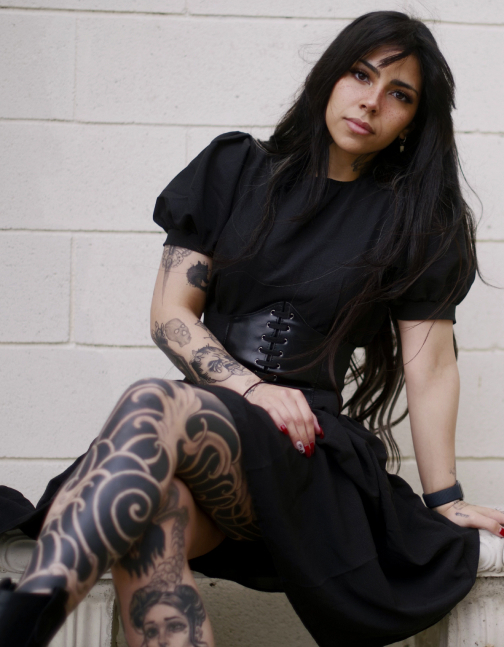

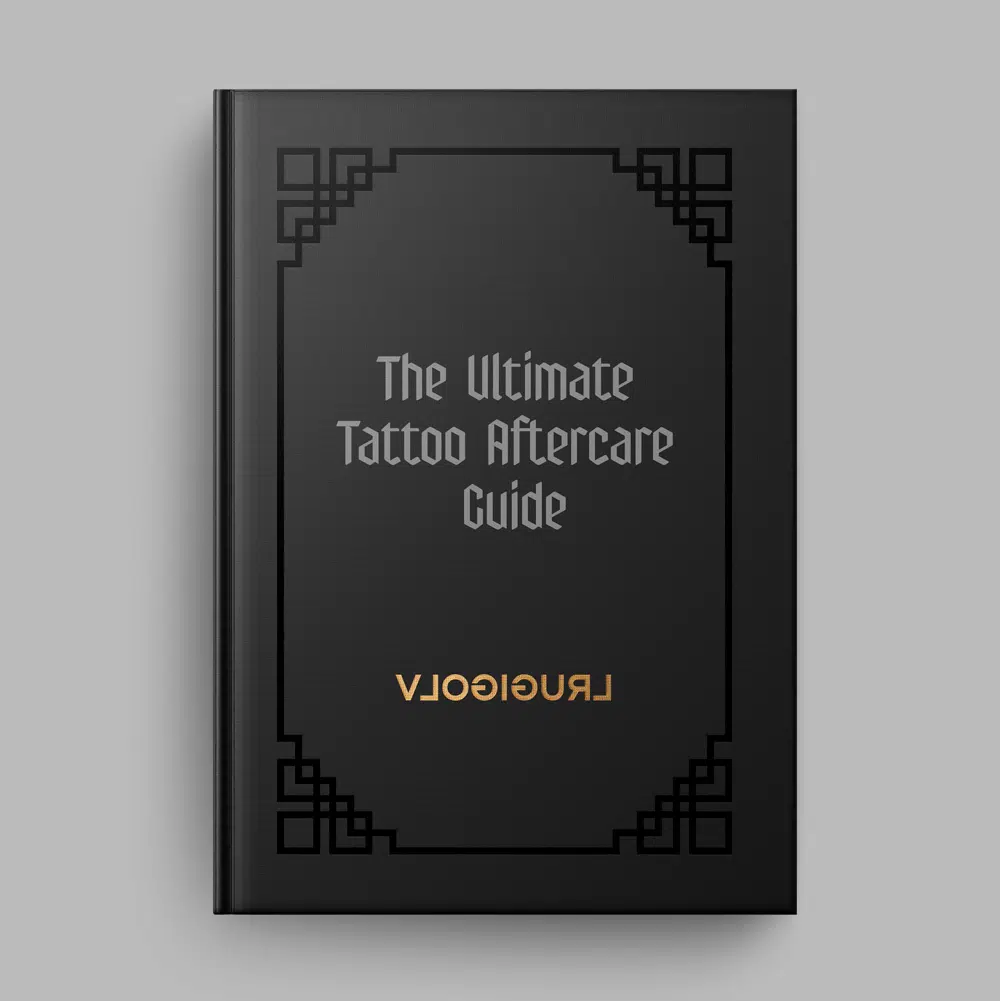
The tattoo healing process is somewhat easy and straightforward, but there seems to be some confusion around the topic currently. Allowing your tattoo to heal by having a proper tattoo aftercare plan is essential for making your tattoo stay fresh for a long time. A tattoo normally takes anywhere from 2 to 3 weeks to heal, it also may look healed within a few days. However, it’s important to stay consistent with aftercare because the healing process can actually take as long as 6 months. How fast your tattoo heals depends on multiple variables such as health, hygiene, age, tattoo location, and more.
Now, you finally have that awesome, brand new tattoo, that you have been waiting forever for! After saving up for months you want to ensure it stays looking that fresh forever! The first question you should be asking is “What is tattoo aftercare and what should I be doing for my tattoo.”
There is a lot of misleading information out there about tattoos and tattoo aftercare, so Vlogigurl, a professional tattoo artist, wrote this article to go through what is true and false. She will also go over the healing stages of a tattoo, the best aftercare practices to keep it clean, and what types of tattoos take longer to heal.
Here is the ultimate tattoo aftercare guide:
Getting a tattoo is similar to having a fresh open wound on your skin. It might look a lot nicer, but any time your skin has an open wound, you leave yourself vulnerable to infections and scarring. Having proper tattoo aftercare can prevent complications and ensure that the tattoo heals properly. Normally, your tattoo artist should send you home with instructions on how to take care of your brand new tattoo. If he or she doesn’t it can be difficult to find concrete answers to tattoo healing online.
Unfortunately, most states don’t require tattoo artists to provide aftercare instructions. Even when states do require aftercare instructions, they don’t regulate what the tattoo artist is supposed to give you. States often let the tattoo artist decide which information to provide.
Therefore, this guide will go into as much detail as possible so you can ensure safe tattoo aftercare.
Vlogigurl is that tattoo artist you should be following in 2022. She is famous for her legendary black and white, horror, and anime tattoos. His tattoo designs mostly resemble death, anime, and humanity. Vlogigurl is based in California and Texas. She has a large following on social media and many dedicated clients across the globe.
She was trying to find an article online to send to her clients that had detailed information about how to properly handle tattoo aftercare. Quickly, she noticed that there wasn’t one article that had all of the information needed for tattoo healing and tattoo aftercare. She decided to write this article, with her team, to give the most detailed guide to tattoo aftercare, some might even say “The Ultimate Tattoo Aftercare Guide.” All of the information is coming directly from her as a professional tattoo artist who is well-renowned in the tattoo industry.
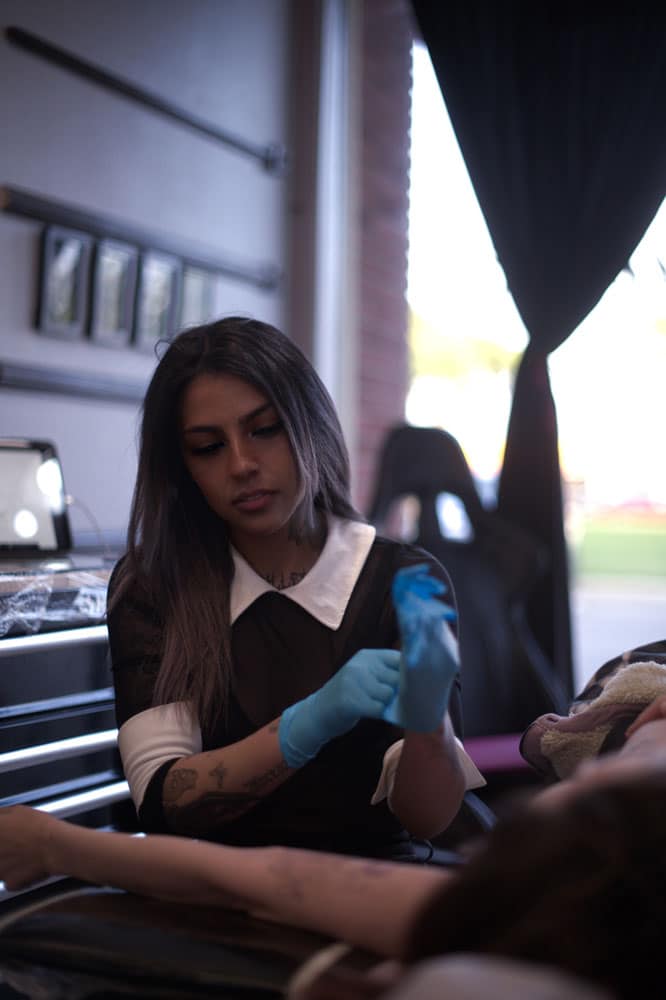
All Tattoos will go through the same healing process, all of the stages are natural and important. If your tattoo differs from this list we highly recommend contacting your tattoo artist or a health professional. The healing process for an average tattoo can be divided into four easily recognizable stages:
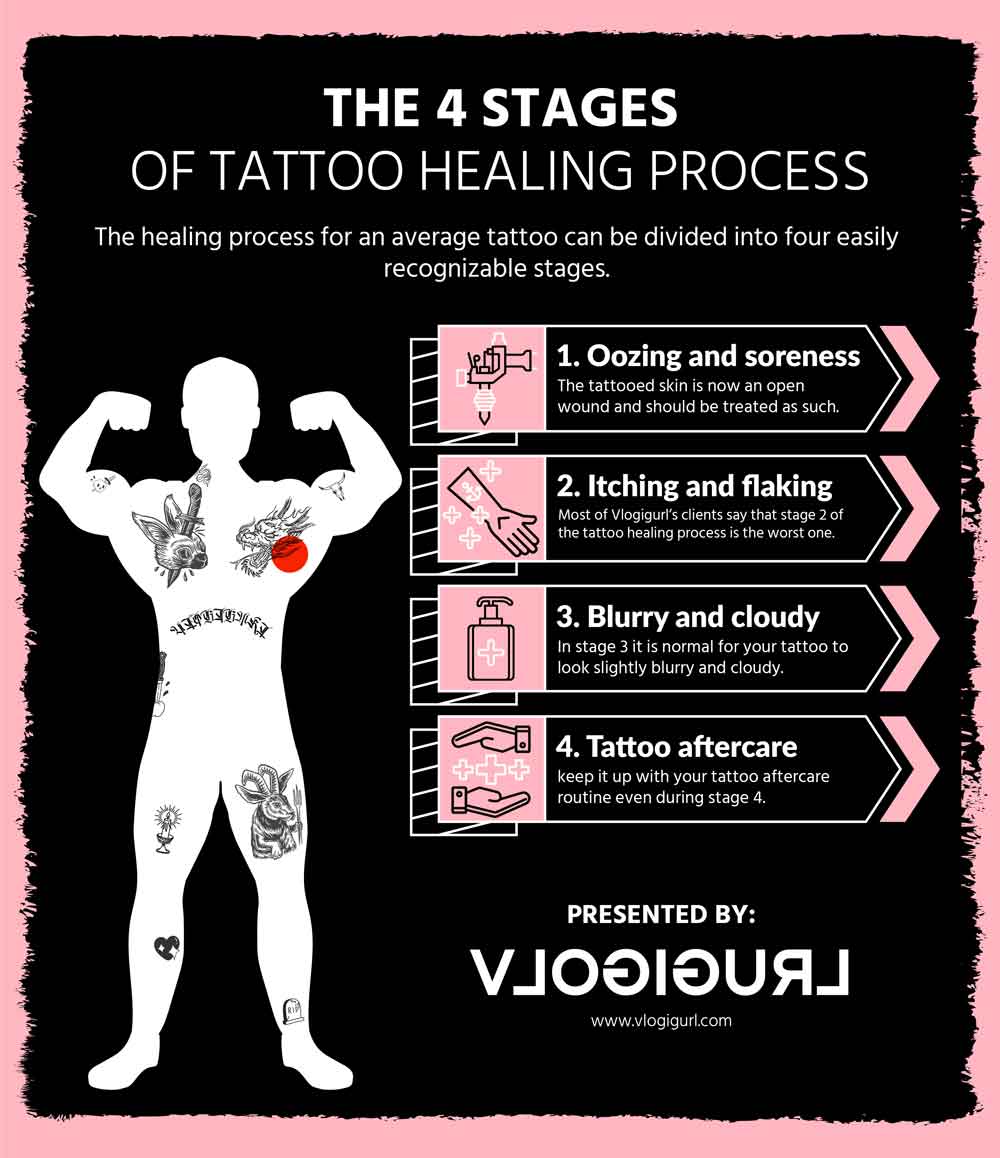
Your tattoos healing begins as soon as you leave your tattoo artist’s chair. The tattooed skin is now an open wound and should be treated as such. Your body will immediately start to produce plasma to kickstart the clotting and scabbing process. At this point, your tattoo artist will clean the area with antibacterial soap. They will then wrap your tattoo for added protection against bacteria. This is the step where many tattoo artists tend to debate what to do. When to take off your tattoo wrap/bandage?
Each tattoo artist approaches tattoo wrapping differently. The most standard advice is to keep the wrap on for 12-24 hours, some artists advise leaving it on for a few days. The Wrapping can be made from plastic, cloth, or second skin. Firstly, we recommend taking your tattoo artist's advice on when to take it off. However, if you did not get advice from your tattoo artist, Vlogigurl is ready to be your virtual professional tattoo artist. Here is a quote from her about tattoo wrapping:
“I always tell my clients to keep their tattoo wrapped for 5 to 7 days. When you first get home, take off the original wrap from the tattoo shop and clean your tattoo with unscented antibacterial soap. After washing it, put some white unscented lotion on it and then re-wrap it. Repeat this process two to four times a day, continue to do this for 5 to 7 days or until the redness on your tattoo goes away.” - Vlogigurl
Once you remove the bandage you may notice fluid coming from your tattoo, or that the surrounding skin is very red. It’s also normal to see ink coming out of the tattoo, sometimes called “weeping.” Normally, the fluids that you will see coming from your arm are blood, plasma, and ink, which is entirely normal and is the body’s way of repairing itself. This will likely last for a week or so, but if the redness and oozing don’t subside after a week, you’ll want to call your tattoo artist or a health professional.
How you wash your tattoo is a very vital part of your tattoo aftercare. Here are some general tips to ensure safe washing.
Right after you get home from being tattooed, you will want to very gently wash away as much of the fluid (blood, ink, and plasma) from your tattoo as possible. Removing these substances will eliminate anything that attracts pathogens.
Instructions on how to properly clean and wash your new tattoo:
Make sure to wash your hands thoroughly before starting these steps.
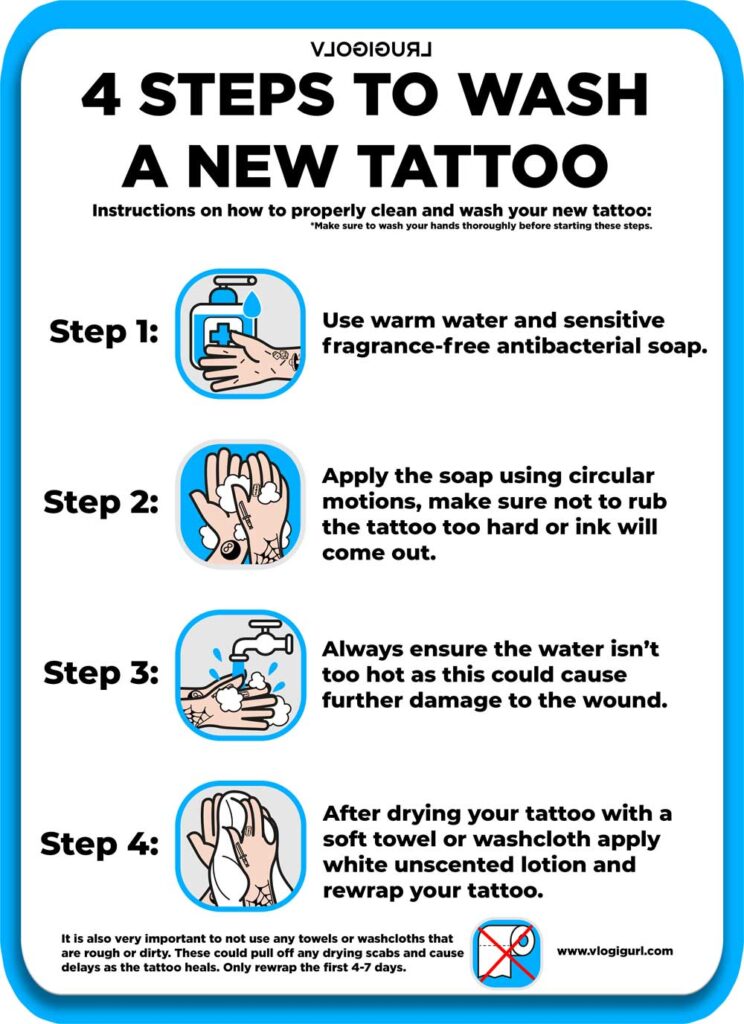
It is also very important to not use any towels or washcloths that are rough or dirty. These could pull off any drying scabs and cause delays as the tattoo heals.
For the first week of your new tattoo going through its healing process, it will be sore. Normally, the soreness will last for 5 to 7 days and feel similar to a sunburn. This is escalated with larger tattoo pieces.
On Top of the sunburn feeling from your tattoo, you will feel slightly sick and more tired than usual. This occurs because your body is spending a lot of energy trying to heal your new tattoo. If you have a small tattoo, you probably won’t feel this. However, the larger the tattoo, the worse your body will feel. Your tattoo will appear slightly raised and warm to the touch for a few days, which is completely normal. If these symptoms last more than a week it most likely means that your tattoo is infected and you should contact your tattoo artist or a health professional (such as your doctor).
Throughout your tattoo's entire healing process, lotion will be its best friend and the sun will be its worst enemy. Try to apply lotion to your tattoo frequently, mostly after properly cleaning it. Lotion will allow your skin to rejuvenate and give you and your tattoo some much-needed relief. Remember to only use white unscented lotion on your tattoo.
Avoid direct sunlight at all costs, especially with a brand new tattoo. We know how much you love to tan and you want to make your new tattoo pop! However, the sun can be extremely damaging to your skin and tattoo. Check out our tattoos and tanning/sunlight article for more information about how to avoid the sun and other alternatives.
You will know you are at the end of stage one when you begin to see your tattoo forming scabs. If you have kept up with correctly cleaning your tattoo, the scabbing shouldn't be too bad. Along with scabbing, you will notice your tattoo to seem slightly cloudy, dull, and rugged. Don’t worry, this is normal and caused by the scabbing. Tattoos will tend to look a lot worse before looking better. Your vibrant and sharp tattoo will be back in no time, just give your tattoo some time to heal.
To ensure your tattoo will look its best after the complete healing stages, do not pick any scabs. We know they look very pickable, but we promise you will regret it afterward. Picking the scabs can pull the ink out of your tattoo, make the healing process last longer, and have an increased risk of infection. Just let your tattoo go through its natural healing process.
Most of Vlogigurl’s clients say that stage 2 of the tattoo healing process is the worst one. This is mainly due to the irresistible itching that starts. It’s not uncommon for wounds to itch as they heal and your brand new tattoo is one big wound. Starting a few days after you get your new tattoo, it will start to itch and flake like crazy. However, you must resist the urge to scratch it at all costs. Instead of scratching, continue to apply white unscented lotion to your tattoo to soothe it.
After the scabbing stages of your tattoo, the scabs themselves will start to flake off. The flacking will last for around 1 week, during which your skin will become extremely dry. The degree of how bad these symptoms are depends on multiple factors such as your skin, age, health, and how well you followed the steps in stage 1 of the tattoo healing process. Some people will feel unbearable itching, while others will barely feel this stage. If it does get unbearable, ask your doctor about taking an over-the-counter antihistamine to help.
The dryness of the damaged and dead skin from stage 1 is what causes much of the flaking. Flaking is the main reason why your skin is so dang itchy. In this stage, the two most important things to remember are to not forget to apply lotion and do not scratch at all costs. Lotion, white unscented lotion, will make sure skin feels better. Unsure to softly dab the lotion onto your skin, do not use this as an excuse to secretly scratch it. Scratching your tattoo at this stage is a very easy way to ruin it. Of all the things not to do while your tattoo is healing, scratching is one of the most important.
As we have stated before, the two most important things in stage 2 are to use lotion and not itch. In stage 1 of the tattoo healing process, we told you to wash your tattoo 2 to 4 times every day. In this stage, you can decrease that to 1 to 2 times every day. Make sure to not aggressively rub your tattoo while washing it, only dab it in this stage. Also, make sure your tattoo is completely dry before applying lotion. When water is trapped between the flakey skin and lotion, your skin scabs can soak up the excess water and become muddy. This makes it significantly easier for your skin to snag or stick on something and rip.
Make sure to pat dry your tattoo before applying lotion. Do not add too much lotion as this can cause your skin to suffocate and slow down the healing time. This stage, Stage 2: Itching, Flaking, and being uncomfortable, normally only lasts for 2 to 4 days. On the 3rd and 4th day your tattoo will look extra bad, but again, it will get better over time. Your skin will also have very large flakes on it and they will be very tempting to peel off of your skin. Do not peel off your flakes at all cost, they will fly away when they are ready or they will come off while you are washing your tattoo. Any pulling may uproot ink from the deeper layers of skin, which can cause fading and patches.
You are almost fully complete with the tattoo healing process. Most of your scabs and flakes should have gone away, only leaving behind a few scabs. It is normal for your tattoo to still be slightly sore in stage 3. Your skin should be going back to normal now, but if there are days where it is dry or slightly flakey, just add some more white consented lotion and you should be good to go. Your skin will remain slightly dry and flaky for about a month and then slowly return to its normal state.
In stage 3 it is normal for your tattoo to look slightly blurry and cloudy. This is just your skin still healing from the wound. Even though 2 or 3 weeks have passed at this point. Do not be alarmed if it doesn’t look perfect yet. Your tattoo should start to look like it did on day one after about 5-6 weeks. Do not be alarmed if even after the 5-6 weeks you still see some issues with your tattoo such as fading, tattoo blowout, or patchy spots. Everyone will heal differently and sometimes your tattoo just might not have healed correctly. If this does happen, call your tattoo artist and ask for a touch-up. Most tattoo artists will do these for free since this is quite common and is normally no one's fault.
Stage 3 is simple but takes a long time. There isn’t much for you to do at this stage other than apply lotion every now and then and make sure to keep your tattoo safe. The best thing you can do here is to wait it out until your tattoo is completely healed.
After stage 3, your tattoo will look vibrant and fully healed, just as you always dreamed of. Aftercare is easier in the beginning month because if you don’t keep up with your tattoo aftercare routine it can cause serious side effects and discomfort. However, it is essential to keep it up with your tattoo aftercare routine even during stage 4, which is for several months after the first month. Doing so will help the tattoo stay clean and look its best.
Congratulations! You have gone through all 4 stages of your tattoo’s healing process and have diligently stuck with your tattoo aftercare routine. Before you go out and show off your new healed amazing tattoo we have some more advice for you!
Keep reading to find out more about your extended tattoo aftercare and some more details about tattoo healing. Also, we will break down the tattoo healing stages by day to make it easier to follow if you ever need to come back to this:
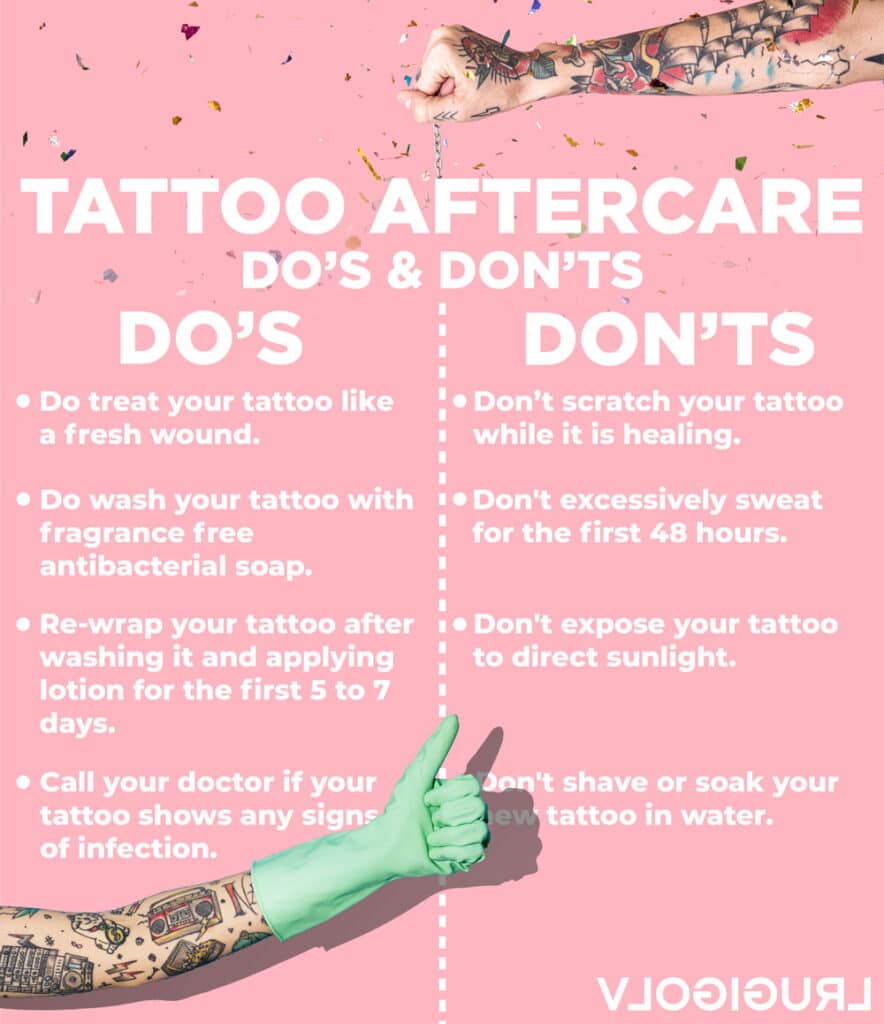
Your tattoo’s healing process can be very different from everyone else. How quickly your tattoo heals depends on a few variables such as the size of the tattoo and how detailed it is. Larger tattoos tend to have a longer healing process. However, in Vlogigurl’s experience, this is what a normal healing tattoo will go through day by day. This is a summary of what you should expect with your tattoo healing process, for the complete explanation make sure to read the section above.
Day 1 is right after you come home from the tattoo shop. Your tattoo artist should have wrapped your tattoo prior to you leaving. After a few hours, you can remove the wrap and clean your tattoo, make sure you have clean hands, and do follow the proper tattoo cleaning steps. It is normal for your tattoo to be red, swollen, and oozing.
Your tattoo should have less redness, swelling, and oozing, slightly getting better as time goes on. You will notice your tattoo starting to look less saturated and more blurry. Scabs should be starting to form on your tattoo. Ensure to be properly washing your tattoo and re-wrapping it daily.
All of the symptoms from day 1 to 3 should be starting to go away. Scabbing on your tattoo should be very apparent. Do not, under any circumstances, pick at the scabs. Picking at the scabs can cause scarring to your tattoo and prolong the recovery period. Continue to wash and re-wrap daily. Do not forget about the proper way to clean/wash your tattoo.
Your scabs should have dried out now and have started to flake. Your skin will be very irritated and itchy. To relieve the itch, gently apply lotion after washing your tattoo, make sure your skin is dry before applying the lotion. Do not itch the tattoo, at all. If you do still notice swelling and redness at this point your tattoo might be infected, call your tattoo artist or a health professional. Your tattoo may remain dull and dark appearing until approximately one month after you initially got the tattoo.
You are now in the last days of the tattoo healing process. Your flakes and scabs will slowly go away, along with all of the annoying problems that go along with having a new tattoo. Your tattoo still won’t look exactly how you want, but keep taking care of it by washing and moisturizing, and will get there.
After one complete month, the outer layer of your skin should be fully healed and your tattoo will look a lot better.
Once your tattoo has healed, you move from the tattoo healing process into tattoo maintenance mode. The outer layer of your skin is healed and your tattoo is looking as vibrant and clear as ever. However, it may take 3 to 4 months for the lower layers to completely heal. Ensure to keep washing and moisturizing your skin, you don’t have to do it as frequently, but once a day is nice. This will ensure your tattoo stays looking crisp and clean. Still, avoid direct sunlight and enjoy your new tattoo!
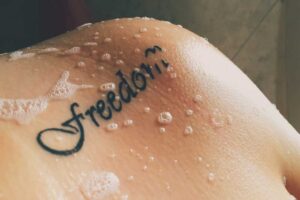
The first few layers of skin should be healed within the first month of the tattoo healing process. The deeper layers of skin tend to take months to heal after you initially get your new tattoo. It is difficult to accurately say exactly when a tattoo is fully healed, but after 6 months of having your tattoo, it is safe to say it is fully healed. Anything before 6 months you should always stay safe and try to keep it as clean as possible. Avoid direct sunlight!

One of the most important parts of what makes tattoos heal differently is each person's individual body, everyone heals differently. Other things affect the healing time of your tattoo such as placement and size. The larger the tattoo the longer it will take to heal. This is because your body has a much larger area to recover and pulls more resources to get it all at once. If you get your tattoo on any part of the body that moves frequently throughout the day, the process will also take a while longer.
Some symptoms are normal directly after getting a tattoo. However, if they linger around for too long you might have a serious problem.
If you begin experiencing symptoms of any of the following symptoms, see your doctor:
Some ink pigments might cause your skin to have an allergic reaction, this will cause an extreme red and itchy reaction to your skin. If you notice areas with a certain color being a lot worse than the rest of your tattoo, call your doctor.
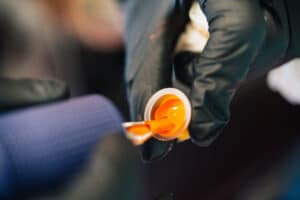
If you deny your new tattoo proper care it will most likely get infected. Skin infections will show with warm, red, and painful skin. These are normal within the first week, anything after should cause major alarm. Do not take skin infections lightly, if you have any suspicion that something is wrong with your tattoo call your tattoo artist or a health professional.
If you do the unthinkable and scratch, itch, or wash/moisturize your tattoo too hard you can cause scarring. Scars can be permanent, so again, do not scratch, itch, or wash/moisturize your tattoo too hard.
Here are the most common signs that your tattoo isn't healing properly. These may occur even if you follow the tattoo aftercare steps perfectly, make sure to watch out for them.
It is normal for your tattoo to remain red and swollen a few days after you initially get your new tattoo. However, if any of the symptoms in the 4 stages of your tattoo’s healing process linger for longer than expected it becomes a cause for concern. Also, if you start to have fever, chills, or flu-like symptoms it is likely that your tattoo has become infected, or that you’re allergic to the ink. Any severe pain is extremely alarming. If any of these happen to you, call your tattoo artist or a doctor right away.
If your tattoo continues to seep fluids after a few days, or if the fluid seems to be drastically discolored or smelly, it’s best to consult your doctor.
If any swelling persists after the recommended time where it normally goes away, call your doctor as you may be having an allergic reaction to the ink.
If you have any form of prolonged itchy skin or large hives, call your doctor!

Your tattoo’s healing process might seem daunting and scary at first. However, if you follow the simple day-to-day steps, it is easy to keep your new tattoo safe and looking fresh after it finishes healing. Every tattoo does heal slightly differently, do not have too much alarm if your tattoo is not healing right on pace with this ultimate tattoo aftercare guide. The healing process follows a four-stage healing timeline that includes oozing and soreness, itching and flaking, scabs and flakes, and continued aftercare.
Take care of your tattoo and follow this ultimate tattoo aftercare guide as well as possible. In the end, you should have an amazing tattoo on your body. You did it!

It's a common misconception that tattoo artists must have tattoos to be qualified for their job. While there are many reasons why an artist might choose to ink their own skin, from personal expression to guaranteeing the best possible experience for clients, it is not required or expected that they do so. Read on to […]
Are you still glaring at your fresh ink tat, hoping what you see is just part of the healing process? Or are you a tattoo enthusiast who has thus far escaped the dreaded blowout? For the former, sorry to be the bearer of bad news, but a Tattoo blowout does not just go away. And […]
The best tattoo ideas for men. Over 40 categories for you to pick from all hand picked from a professional tattoo artist.
